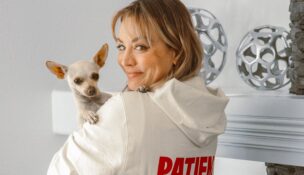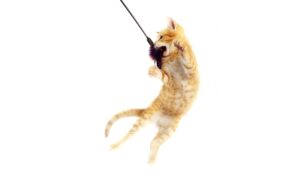Stocking Stores for Puppies and Kittens
Chris Junior //March 11, 2020//
No matter if they label themselves “pet parents” or use the term “fur babies” to describe their companion animals, the owners of dogs and cats play maternal and paternal roles when raising newborn pets. Proper feeding, teaching and nurturing are among their regular responsibilities and obligations. Those efforts by owners not only contribute to having healthy, fit and well-behaved pets but also to establishing homes where all occupants—whether they have two legs or four—are welcome members of the family.
“I always warn my clients that having a new puppy or kitten is like having a new baby in the house,” said Dr. Ginny Bischel of Eastlake Village Veterinary Clinic in Chula Vista, California. “[It’s important to ensure] that they are receiving the necessary immunizations to keep them protected from viruses and diseases that mostly affect young pets.”
Beyond vet-related services, kittens and puppies require regular monitoring and safeguarding, adds Dr. Bischel, along with frequent, high-protein meals “since they expend so much energy when they are young.” And when it comes to specific foods for juvenile cats and dogs, plus other essentials they need on a daily basis, a well-stocked store can contribute to the overall welfare of these pets and their development process.
Proper Nutrition
“The greatest nutritional demand for a pet occurs early in life,” said Bryan Nieman, brand director and fifth-generation family member at Fromm Family Foods. “As a result, puppy- and kitten-specific diets are more nutrient-dense to meet these needs. It’s most important for pet parents to find a nutritionally complete diet to help support a growing animal, and finding a food that uses quality ingredients and adheres to meticulous and safe manufacturing practices.”
As part of the Fromm Gold Nutritionals rollout in 1999 commemorating the golden anniversary of Fromm Dog Meal, the company’s first dog meal, Fromm introduced Puppy Gold, followed by Kitten Gold in 2006. Nieman says Fromm Gold was designed to provide complete nutrition at specific stages within a pet’s life cycle. Puppy Gold and Kitten Gold are formulated for the needs of growing pets, he adds, using select proteins such as chicken and ingredients such as whole oats enhanced with probiotics to assist in digestion, along with salmon oil for healthy coats.
Compared to adult cats, kittens require two to three times more protein, fat and other nutrients, Purina states in an online article on its website. The company’s Pro Plan series has a kitten line with dry and canned choices. Chicken and salmon are among the top common ingredients, with the canned options each containing at least 12 percent crude protein, while the dry options have a minimum of 41 percent.
In a separate website story, Purina stresses that puppies need food that’s dense in nutrients and high in calories in order to support their development and rapid growth. Within the Pro Plan options are two chicken and egg dry formulas, one for large breeds (dogs over 50 pounds at maturity) that has 404 kilocalories per cup and another for pooches up to one year old that packs 483 kilocalories per cup. There are also Pro Plan versions for small breed and toy breed puppies.
Just like humans, pets stand to benefit from a diet that also incorporates supplements. When California-based Vetericyn noticed there were “many gaps in clinical evidence and in pet parent satisfaction” with regard to dog supplements, says vice president Scott Van Winkle, his animal wellness company spent more than three years developing what is the ALL-IN supplement line. Launched in late 2019, ALL-IN tablets come in puppy, adult and senior formulations.
“Because a dog’s nutritional needs and physiology change as they age, we set out to create a supplement that would be effective at each age class,” explained Van Winkle. “The result is a much more targeted, balanced and effective supplement than anything else on the market.”
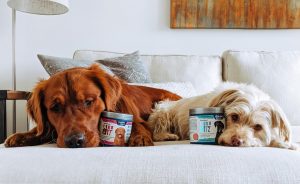 ALL-IN Puppy, for dogs up to 18 months, is designed to provide factors for bone development, maintain a healthy intestinal tract, enhance immune system response and help reduce hyperactivity, among other benefits.
ALL-IN Puppy, for dogs up to 18 months, is designed to provide factors for bone development, maintain a healthy intestinal tract, enhance immune system response and help reduce hyperactivity, among other benefits.
“A growing puppy’s systems are building a foundation for a lifetime,” said Van Winkle. “[ALL-IN Puppy] targets a puppy’s vital systems with the support it needs during the critical period when they are weaned from their mother’s milk to solid food.”
Van Winkle credits scientist-professor Dr. A.S. Narain Naidu for solving issues related to supplement absorption.
“When Dr. Naidu explained the technology he developed could actively take the nutrients, move them through the body and then deliver them to the right cells, we knew we had something special,” he said. “Working with Dr. Naidu, we created customized nutritional complexes, which help strengthen bones and tissue, optimize gut health and strengthen the immune system.”
Even when product recommendations and ingredients are taken into consideration, the possibility still exists that what is served to kittens and dogs will not agree with them, resulting in various physical reactions. 5Strands Affordable Testing, based in Lawrenceville, Georgia, aims to identify nutrition-related intolerances in cats and dogs through specific tests. The only requirement is 10-15 strands of hair, and turnaround time for the comprehensive test results and accompanying comprehension sheet (sent by email) is five to seven days, according to the 5Strands site.
Ethan Steed, a co-founder of 5Strands and its chief operating officer, applied the food test to Hammer, his 13-year-old pitbull/American bulldog. The results said Hammer was intolerant to beef.
“He always licked his paws and had a dry spot on his tail, so once I removed that from his diet, I began to see his tail fill in with hair, and he licked his paws less,” said Steed.
“When introducing a new member to the family, it’s always best to know what foods are going to agree with them, mainly knowing what not to feed them,” he added. “You can test your new pet as soon as it has hair… I would recommend waiting until at least six months old, but just as your pet is still growing, the intolerances could change as well.”
When Nature Calls
Some break it down to a series of steps; others frame the task as something that can be accomplished in a matter of days. Nevertheless, when it comes to housetraining, this aspect of kitten and puppy ownership demands a good deal of patience and persistence, not to mention a strategic effort and specific products.
For kittens, the first thing to do is provide an accessible litter box, as they don’t have the degree of control that mature cats possess and need to have litter boxes nearby to avoid traveling too far, explains Gina Zaro, marketing director for Dr. Elsey’s Cat Products.
“By putting them in a litter box, they associate the box with the reflex,” she added. “After feeding time, it is a good idea to place your kitten into a litter box. Kittens have a natural elimination reflex after eating. You should also create easy access for kittens by placing a step up until they are large enough to be able to get in the box easily by themselves.”
The right litter is also essential during the housetraining process, and she recommends her company’s Kitten Attract option, which has been on the market since 2007.
“[It’s] made of premium scoopable litter with superior clumping ability and ground to an ideal granule size and texture for a kitten’s tender paws,” she said. “Kitten Attract litter contains a specific natural herb attractant that piques a kitten’s curiosity to use the litter box. The combination of herbs, texture and particle size provides a unique and effective solution for owners of kittens.”
While Dr. Bischel says kittens are “very easily box trained,” puppies require “a bit more work” to get them into desired housetraining habits—i.e., doing all of their business outdoors. She adds that consistently using pee pads, each time moving them closer to the door where the dog should eventually exit, can expedite the process.
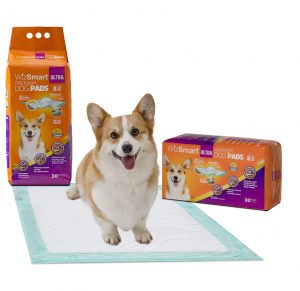
Fueled in part by complaints about pee pads in general from customers who visited its store in Sao Paulo, Brazil, Petix developed WizSmart dog pads. They are made with virgin fibers and material from unused, reclaimed baby diapers. In addition to sealed edges to stop leaking, WizSmart pads contain what is described on their packaging as a “unique dog attractant.” As for what makes the scent appealing to canines, Krister Holm, general manager for WizSmart, defers to the users of the product.
“You would have to ask the dogs!” he said. “Humans cannot smell the fragrance. We had a fragrance-maker produce something irresistible that only dogs will sense and that does not contain synthetic pheromones.”
WizSmart pads come in three versions, and Holm says the size of the dog and intended use should be taken into consideration before making a choice.
“If you want maximum absorbency and peace of mind for the entire day, up to 24 hours, go with our WizSmart Ultra [eight cups absorbency] pads,” he said. “And if it’s a large breed, get the WizSmart Ultra XL eight-plus cups… [and if] it’s a small breed, then WizSmart Super [with five cups absorbency] will do the job.”
Thanks to their adhesive tabs, WizSmart pads address the male-dog aspect of urination and the overall concern regarding how to secure them to floors and walls. The company recommends bringing puppies to a WizSmart pad several times per day, especially after they’ve had something to eat or drink, and to offer praise for each successful elimination.
Conditioning, along with communication, are essential in using PoochieBells, a doorknob-hanging bell for dogs to signal to their owners that they need to go outside.
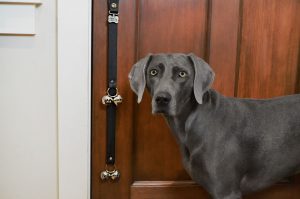 “Based on [physiologist Ivan] Pavlov’s theory of conditioning, the idea is to teach your dog to associate the need to go potty with ringing the bell,” explained Cheryl Pedersen, co-founder of Only an Ocean and its Poochie-Pets division. “We always recommend praise instead of food treats, as we want a long-term learned action and result.”
“Based on [physiologist Ivan] Pavlov’s theory of conditioning, the idea is to teach your dog to associate the need to go potty with ringing the bell,” explained Cheryl Pedersen, co-founder of Only an Ocean and its Poochie-Pets division. “We always recommend praise instead of food treats, as we want a long-term learned action and result.”
After a dog gets to smell, touch and hear PoochieBells, the next step is association, says Pedersen.
“Every time you take your dog out for the first three to five days, ring the bells in front of him so he can see and hear the bells,” she explained. “Celebrate and take the dog out, [without] treats—just [offer] praise after your dog does his business.”
Keep repeating the association process until your dog starts ringing the bells on his own, says Pedersen. “Once he does, [offer] praise as reward,” she added. “Do not play outside with your dog or any other behavior you don’t want associated with ringing the bells—it should be just for potty time.”
Managing Problem Behaviors
As they become accustomed to their indoor surroundings and interact with their owners and others, puppies and kittens will not necessarily exhibit appropriate, desired demeanor. That’s where products with preventative and corrective benefits come into play.
During the “crucial socialization window” of eight to 16 weeks of age, while teaching a puppy obedience behaviors such as to sit or stay, problem behaviors such as jumping on guests can also be addressed, says Jamie Popper, a certified professional dog trainer. She’s a proponent of what’s known as platform or station training.
“There is a reason zoo animal trainers teach a ‘station’ behavior as one of the animal’s first skills,” said Popper, who is also a Pet Age columnist and a business development manager for Blue-9 Pet Products. “When an animal is on a station, they become more focused on the trainer. The animal is less likely to become distracted by things in the environment. With increased focus and decreased interruptions, the training session runs much more smoothly, allowing the trainer to accomplish the task.”
Blue-9 makes the KLIMB, a table-style dog-training platform featuring PawGrip, a proprietary slip-free surface, along with removable legs for easy transport.
“It’s very easy to teach a puppy to go to the KLIMB and stay there during scenarios where they might otherwise make poor decisions,” said Popper. “When guests arrive at the home, send your puppy to the KLIMB to wait patiently rather than jumping all over your guest. Or as you prepare you or your pup’s dinner, have them wait on the KLIMB to prevent begging or getting underfoot.”
Popper recommends spending five to 10 minutes per KLIMB session with a puppy at first. To train a dog to go to its KLIMB and stay there even during distracting environments, she says to practice twice daily for 10 minutes per session for 14 days. (Blue-9’s website has several KLIMB training videos with accompanying instructions.)
“As you progress your training, the KLIMB can be used for teaching canine fitness skills, foundation behaviors for competitive sports like agility or disc dog and used for trick training and enrichment sessions,” Popper said. “The uses are endless.”
While dogs may be prone to jumping, cats have a tendency to scratch, which is a natural instinct that helps them feel a sense of territorial ownership by leaving visual and scent marks, explains Kate Benjamin, a best-selling author, the founder-owner of Hauspanther and designer of the Hauspanther Collection by Primetime Petz.
“Scratching also helps a cat groom their claws and allows them to stretch their muscles,” she said. “It’s very important to give a cat a designated place to scratch, otherwise they will find their own place, and you may not like it.”
The Hauspanther Collection has two scratchers that are ideal for kittens, says Benjamin. One is the large, sturdy MaxScratch, which has extra-thick jute rope wrapped around a wide-diameter column, creating a built-in perch on top.
“There is no other scratcher on the market that is this diameter with a perch that is already built in,” she said. “Kittens absolutely love to climb all the way to the top of a scratcher and sit. In addition to giving them an appropriate place to scratch, it really helps them to get out a lot of kitten energy when they climb the MaxScratch.”
Then there’s the Scratch Pole, which she says provides “a sturdy scratching surface in a compact space.” Its telescoping parts allow for adjusting the scratcher to fit under any standard height table or desk, “holding it in place with tension,” says Benjamin.
“It takes up very little floor space and takes advantage of unused space,” she added. “The natural seagrass scratching surface is attractive to cats, and the matching seagrass toy encourages cats to scratch.”
There are times when puppy containment inside the home is in order, something Victoria Bouldin of Primetime Petz knows about firsthand. A struggle to find a nice gate for her Pekingese poodle mix puppy contributed to the Primetime Petz philosophy that pet furniture “should not have to look unsightly,” says Bouldin, the company’s vice president of operations.
“We have made it our mission to design solution-based products that look good in pet owners’ homes,” she said.
Primetime Petz designs and manufactures various styles of pet gates, some made for other brands. Bouldin says the Primetime Petz Safety Mate Gate, featuring a sturdy wall-mounting system, is made specifically with young dogs in mind, “as it provides a superior amount of security and protection for puppies, with its impenetrable design.”
Security, protection, nutrition, training: Kittens and puppies require a lot, but their owners—and those who do business with them—get a lot in return.
“Pets are an important part of the American household,” the American Veterinary Medical Association writes on its website. “A pet will be part of your life for many years. Invest the time and effort necessary to make your years together happy ones.”









